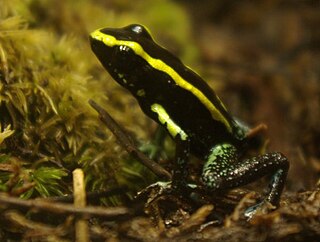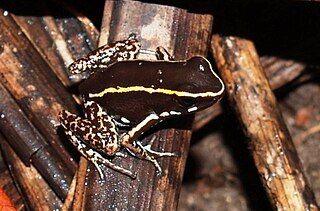 W
WPhyllobates is a genus of poison dart frogs native to Central and South America, from Nicaragua to Colombia. There are 3 different Colombian species of Phyllobates. These frogs are an endangered, yet toxic species due to the poison they contain. Phyllobates located in countries such as Costa Rica and Panama are not known to be toxic, as those in Central America.
 W
WPhyllobates sp. aff. aurotaenia is a temporary name given to a likely new species of poison dart frog, formerly known as the "red" form of Phyllobates aurotaenia. It is morphologically similar to P. aurotaenia, but genetically it is more closely related to P. terribilis. It can be distinguished from P. aurotaenia by its uniform chocolate brown or navy blue body, and its orange or red, rather than green or yellow, stripes.
 W
WPhyllobates aurotaenia is a member of the frog family Dendrobatidae, which are found in the tropical environments of Central and South America. First described by zoologist George Albert Boulenger in 1913, P. aurotaenia is known for being the third most poisonous frog in the world. It is the smallest of the poison dart frogs in the Phyllobates genus and is endemic to the Pacific coast of Colombia.
 W
WThe golden poison frog, also known as the golden frog, golden poison arrow frog, or golden dart frog, is a poison dart frog endemic to the Pacific coast of Colombia. The optimal habitat of P. terribilis is the rainforest with high rain rates, altitudes from sea level to 200 m elevation, temperatures of at least 26 °C, and relative humidity of 80–90%. In the wild, P. terribilis is largely solitary and territorial; however, captive P. terribilis specimens can live in much larger groups. They may appear innocuous due to their small size and bright color, but wild frogs are lethally toxic.
 W
WThe Golfodulcean poison frog or Golfodulcean poison-arrow frog is a species of frog in the family Dendrobatidae endemic to Costa Rica.
 W
WThe lovely poison frog or lovely poison-arrow frog is a species of frog in the family Dendrobatidae. It is found on the Caribbean versant of Central America from southeastern Nicaragua through Costa Rica to northwestern Panama, with one record just west of the Panama Canal. Populations from the Pacific versant, formerly included in this species, are now identified as Phyllobates vittatus.
 W
WPhyllobates bicolor, also known as the black-legged poison frog, bicolored dart frog or neari in Choco, is the second-most toxic of the wild poison dart frogs. This species obtained its name due to its normally yellow or orange body with black or dark blue hindlegs and forelimbs below the elbow. It lives in the lowland forests in the Chocó area in western Colombia, along the San Juan River.